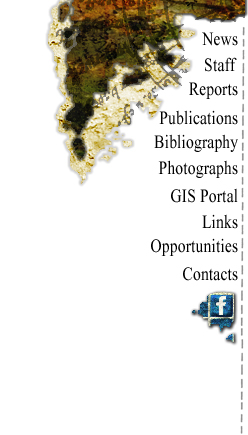 2013
2013
26 July 2013 - THE AROURA G.I.S. PORTAL IS NOW OPEN TO THE PUBLIC
Now that the American and Greek partners have come to an agreement on open-access data, the AROURA GIS portal is available to the public, the data hosted by arcgis.com. One has only to fill in a short application form (MS Excel format) declaring name, address, and purpose of wanting to study the data, in order to receive a username and password to the read-only interactive site (see screenshots below). The geophysical and surface collection data from every year of the project (2010-2012) are available. Visit our GIS portal page for further information and to download an application form.
5 March 2013 - THE O.S.L. DATING RESULTS ARE IN
It has now officially become a matter of public knowledge. Dr. Nikolaos Zacharias of the University of the Peloponnese, Laboratory of Archaeometry, sent us the results of his optically stimulated luminescence (OSL) dating of features 2011I2-P01 and 2011J1-P01, which were exposed in section during fieldwork in October 2011.
Both of these features correspond exactly in plan to a linear negative magnetic anomaly, detected with the Bartington 601-2 dual fluxgate gradiometer in 2010 and 2011. The former anomaly makes up part of grid-like pattern of such anomalies, often with parallel linear positive anomalies (forming rectangles ca. 27-33 m on a side), within the Bronze Age polder around the Late Helladic (LBA) fortress of Glas, while the latter is one of the linear anomalies that appear to bound this grid-like pattern to its east or else join it to Glas (see the annual reports of 2010, 2011, and 2012 at http://www.umbc.edu/aroura for further information).
2011I2-P01 appears to consist of subsoil (ancient lakebed sediment) deposited to create a raised feature perhaps two meters wide, and so the feature is plausibly the remains of a low levee. This interpretation is consistent with its magnetic character. The parallel positive anomaly may correspond to the fill of an adjoining ditch.
2011J1-P01 likewise looks like a deliberate deposit of subsoil to create a levee perhaps a 1.5-2.0 meters wide -- albeit a few 100s of meters long.
Here are tabulated relevant results.
- 2011I2-P01 (LUM 316/13) OSL 1 (quartz) 3.65 +/- 0.33 ka (1 sigma probability)
- 2011I2-P01 (LUM 317/13) OSL 2 (quartz) 3.70 +/- 0.32 ka (1 sigma)
- 2011J1-P01 (LUM 320/13) OSL 5 (quartz) 3.85 +/- 0.28 ka (1 sigma)
- 2011J1-P01 (LUM 321/13) OSL 6 (quartz) 3.14 +/- 0.20 ka (1 sigma)
The first three dates are remarkably consistent with one another, representing BC dates of ca. 1640+/-330 years (1970-1310), 1690+/-320 (2010-1370), and 1840+/-280 (2120-1560). The first two are tightly corroborated by thermoluminescence (TL) of their calcite fraction, which Dr. Zacharias informs us usually renders dates 15-35% lower than calendar date:
- 2011I2-P01 TL (calcite) 3.29 +/- 0.20 ka (1 sigma probability)
(ca. 1480-1080 BCE + ca. 15-35%)
- 2011I2-P01 TL (calcite) 3.27 +/- 0.20 ka (1 sigma)
(ca. 1460-1060 BCE + ca. 15-35%)
Moreover, 2011I2-P01 corresponds in nature and character to a horizon identified in soil core 2011I2-01 -- taken from above the same linear negative anomaly corresponding to feature 2011I2-P01, and a few meters away -- from which has been obtained an accelerator mass spectrometry carbon-14 (radiocarbon) date (Beta Analytic 331307):
- 2011I2-01 AMS radiocarbon (sediment), 1 sigma level of probability (68%),
- calibrated BC 1860-1850 (cal. BP 3810-3800)
- cal. BC 1770-1720 (cal. BP 3720-3680)
- cal. BC 1720-1690 (cal. BP 3670-3640)
- or, at the 2 sigma level of probability (95%),
- cal. BC 1880-1660 (cal. BP 3830-3610)
- cal. BC 1650-1640 (cal. BP 3600-3590)
The several ranges are the consequence of the peaks and troughs ("wiggles") in the radiocarbon calibration curve, for which the 18th-17th century BC period is particularly infamous.
The foregoing are the results of two radiometric dating methods based on very different principles, and so we have to be cautious when trying to reconcile them.
- The radiocarbon date from 2011I2-01 may be presumed to represent the date of the deposition of the organic fraction of the sediment that was later shaped into the "levee" feature, whereas
- the OSL dates from corresponding 2011I2-P01 presumably represent the date of the "zeroing event" of the construction of said feature (the last time it was exposed sunlight, naturally luminescing its quartz content).
Therefore, the most conservative reading of the combined results of both kinds (at the 1 sigma level of probability) is that the terminus post quem for the construction of the feature is 1860 BC (1880 BC at 2 sigma level), and that the terminus ante quem for its construction is 1310 BC. The construction of the fortress of Glas is dated by artifact seriation and cross-dating to ca. 1300 BC.
It may reasonably be assumed that the feature would be built up of material in conformant natural deposits topmost in the lakebed (perhaps the material removed from an adjacent cut). It is therefore very interesting that the median figure for the first two OSL dates (assumed t.a.q) listed above is very near the low dates from the radiocarbon results (assumed t.p.q.).
The above is a somewhat simplified presentation of the OSL and TL results. Feature 2011I2-P02 produced an anomalously high OSL date (median 4.33-4.25 ka, OSL 4 and OSL 3, respectively), for which, however, no TL equivalent is available. The second OSL date above (LUM 321/13 = OSL 6) is also anomalous, to the degree that it is low (ca. 1330-930 BCE), but it too has no equivalent TL result.
Nonetheless, it is undeniable that the dates sit squarely on the Late Helladic (Late Bronze) Period (conventionally ca. 1700/1600-1050 BC).
AROURA intends to install one more set of OSL dosimeters and to send further samples in storage to the radiocarbon laboratory, in order to corroborate these already robust results.
We are always grateful for your interest and support.
-- MFL
2012
26 December 2012 -- We are excited to announce that the AROURA website is preparing to make its data available on line (expected in the spring of 2013) by means of ESRI's ArcGIS Server service. This will allow visitors to call up geophysical, surface collection, photographic, and other forms of descriptive and quantitative data. Below are some screenshots from the prototype version. Thanks are due to Wes Bittner, AROURA GIS Specialist and photographer, for the effort.
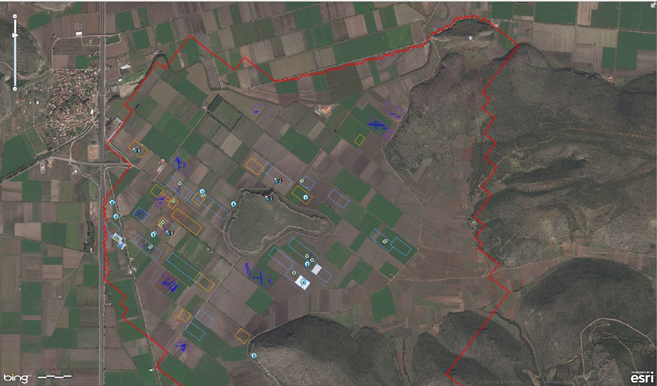
Screenshot 1. Overview of the AROURA Project Area, with the fortress of Glas in the center, with magnetometry transects, magnetic anomalies, and field walking / surface collection areas indicated.
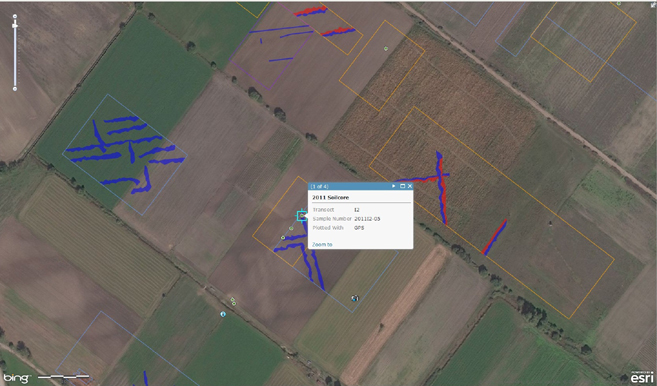
Screenshot 2. The location of soil core 2011I2-05 above a magnetically negative anomaly (blue), the pop-up box giving details.
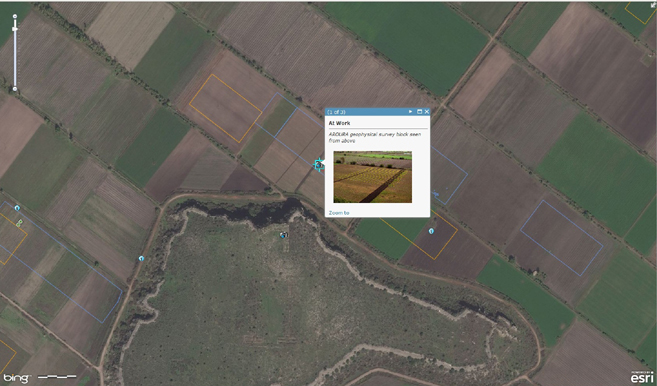
Screenshot 3. Pop-up photograph and caption of the AROURA magnetometry sampling grid laid out in Transect A2, as seen from the summit of Glas.
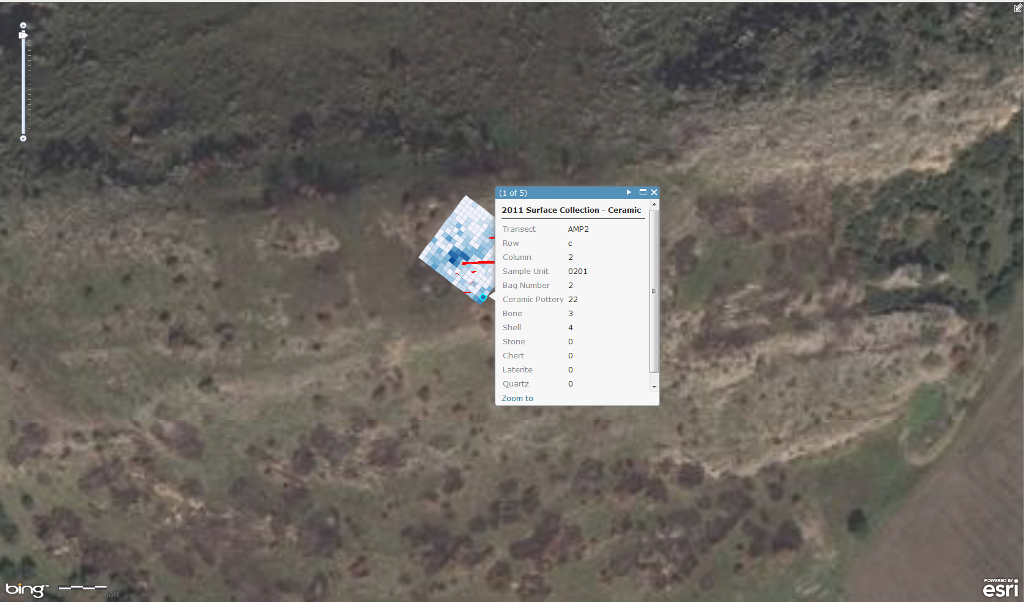
Screenshot 4. Surface collection 30-meter square AMP2c2 at the site of Aghis Marina Pyrghos, the pop-up box giving details of location and finds in 2-meter collection unit 0201.
1 October - 11 November 2012 -- AROURA had a third and final successful field campaign. Read our report here
28 September 2012 -- Dr. Nikos Zacharias of the University of the Peloponnese installed dosimeters for optically stimulated luminescence (OSL) dating in deposits we've exposed that correspond to elements of a certain interesting patterns of magnetic anomalies we've detected.
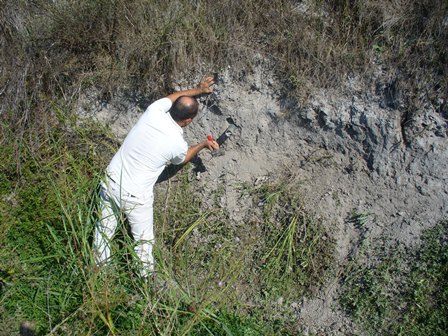
2011
13 May 2011 -- We have received our archaeological permit for this year! Together with our permit from the Institute for Geological and Mineralogical Exploration, issued in March, we are ready to roll!
2010
25 Oct. 2010 -- Halfway through the 2010 campaign. What do we have?
- confirmation that the crop and soil marks correspond to magnetic anomalies -- some positive, others negative, with respect to the magnetic background (NEW info)
- no evidence of further subdivisions of the pattern evident in the crop and soil marks
- evidence that this pattern, in the form of magnetic anomalies, extends to some areas where it is not visible as field marks (NEW info)
- very little on in the way of collectible finds on the surface -- just as we expected (yes, you read right) -- but what there is corresponds neatly to areas delineated by features of known Mycenaean age (NEW info)
- previously undetected subsurface features, particularly within a few hundred meters of Gla's west gate (NEW info).
All together good, if still enigmatic in places.
16 Oct. 2010 -- The president of the Orchomenos city council, Mr. Yperifanos, confirmed for us the location of the Luftwaffe airstrip: a long tract of land by the Mavropotamos (Melas R.), whose far NW end now contains a stand of pine trees.
11 Oct. 2010 -- Ran the first magnetometry traverses in the afternoon.
10 Oct. 2010 -- Tim has arrived to carry out the magnetometry survey.
4 Oct. 2010 -- FIELDWORK HAS BEGUN.
30 Sept. 2010 -- Wes arrives tomorrow, Tim on Oct. 10. Wes and I have our work cut out for us laying out the sampling grid before Tim gets here.
25 Sept. 2010 -- presence of Luftwaffe airbase in vicinity of Gla during WW2 confirmed by resident of Orchomenos. Details to follow soon, we hope....
8 Sept. 2010 -- word came down from on high (Central Archaeological Council) that we have been granted an archaeology permit (finally).
|

